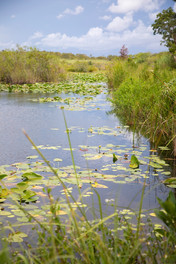Travel Review: Everglades National Park & Biscayne National Park
- Alyssa
- Nov 28, 2023
- 4 min read
Locations:
Entry Fees: The Everglades has a $30 per vehicle entry fee. Biscayne has no entry fee unless camping overnight. More information about the Everglades park fees HERE and the Biscayne park fees HERE.
Parking: There are free parking lots at visitor centers and within the parks.
Biscayne and The Everglades are two National Parks about thirty minutes from each other, making them two parks that can easily be seen in one day if time is short. However, both parks have plenty to do if you're looking to fill a multi-day trip.
These parks may be only half an hour from each other, but they are very different parks. Our day started with a snorkeling excursion in Biscayne National Park. The tour took off from the Dante Fascell Visitor Center just outside of Homestead, FL. There was plenty of parking in the lot at the complex.
The Visitor Center is one of the only parts of the park on land. 95% of the park is actually under water and it's known for its large coral reef and mangrove forests. Biscayne became a national park in 1980, although it had been a national monument since 1968, and was originally part of the proposed boundaries for the Everglades National Park.
The Visitor Center is where Biscayne National Park Institute is located, which is the non-profit educational partner of the park. We booked our snorkeling tour through the institute and so we had to check in for our tour on the second floor with the people in the gift shop and then head back downstairs to pick up our snorkeling gear.
After a short safety demonstration, we boarded a small boat in the marina behind the visitor center and set off toward the snorkeling locations.
The first stop was one of the mangrove forests that line the shallow bay along Elliot Key. We put on our snorkeling gear and hopped into the warm water. The depth along the edge of the bay is only a couple of feet so we really got up close and personal with the sea life here.
The next stop was the Mandalay shipwreck which was out in the open waters past the bay. The shipwreck happened on New Years Day 1966 to a luxury schooner carrying 35 people, all of whom survived.
After a speedy and bumpy boat ride, we arrived at the wreckage site to find a MASSIVE amount of jellyfish, so we didn't venture too far from the boat. We didn't get as up close to the shipwreck as we could have but we still got a glimpse of it and we didn't get stung by any jellyfish so I'd say win-win.
After the shipwreck, we went to a nearby coral reef to finish off our snorkeling excursion. The reef was sadly very bleached due to the excessively warm waters off the coast of Florida this summer.
The sea life here was a lot deeper than at the Mangroves so we had to look closely to catch the fish moving around. Also, the movement of the water was more intense so after a while I did get a little motion sickness from bobbing up and down so much.
On the way back to the visitor center, we made a brief stop at the Boca Chita Key campgrounds where people can dock their boats and even stay overnight camping (which has a fee). We didn't go ashore but we did see many expensive boats docked along the water's edge.
Overall, the snorkeling excursion was really fun and I highly recommend it. The cost of the trip goes to the Institute so it helps fund the educational and experiential arm of the park.
If snorkeling isn't your thing, there are other water activities such as kayaking/canoeing and boat cruises. Check out more information at the Biscayne National Park Institute website.
After we finished our snorkeling trip at Biscayne, we drove about 30 minutes west to the main entrance of Everglades National Park where we made a brief stop at the Ernest F. Coe visitor center before officially heading into the park. After entering, the road goes on for about 38 miles to an area called Flamingo at the other end. On the way, there are occasional trails to walk if so desired; some long, some short. They are all very flat, easy trails due to the topography of the park.
We stopped at the Anhinga Trail which is only a few minutes from the main entrance. It starts at the Royal Palm Visitor Center and takes a lollipop route around the nearby water. It was very hot and humid, and we unfortunately did not catch any glimpses of alligators in the surrounding area. We were told it wasn't the right season. So if you want to see alligators, go in the winter or spring when the weather is better and its their mating season.
Other outdoor activities in the park include biking, boating, camping, and canoeing/kayaking. Earlier in the week, I had the opportunity to take an airboat tour which took off from the northern border of the park along Highway 41. It was an interesting way to see the Everglades and the guide was able to point out some animals including one or two alligator heads in the distance. There's more information about the guided park tours on the NPS website.
Between the Everglades and Biscayne National Park, there's a lot to see and do! Both are unique places with their own animals and ecosystems. They're also windows into how our changing climate can affect our fragile ecosystems and I appreciated the information both parks had about the changes they've seen. To quote Joe Podgor: "The Everglades is a test. If we pass it, we may get to keep the planet.”

Biscayne National Park:
Everglades National Park:


































Comentários